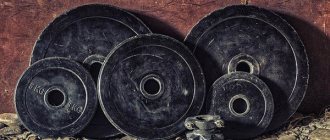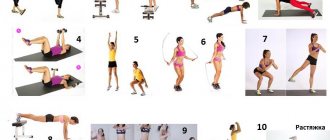The ability to create an individual training plan distinguishes beginners from professionals. To achieve maximum results, it is important to understand how to correctly change the program “to suit you”, as well as how to distribute training of different muscle groups over the days.
In addition, a personal training program involves adherence to a regimen and recording of results. It's impossible to progress in training without carefully analyzing how well (or poorly) specific exercises are working - and whether the workload is increasing.
Of course your goal
Every good workout needs to be tailored to your needs, so you need to set yourself realistic goals and plans. The first step is to set your main goal. Of course, we are talking about your motivation , as a result of which you decided to start training. Decide whether you want to increase strength, gain size and muscle, or lose fat. The second step is to decide how you want to achieve this goal . For example, if you want to lose fat, increase the capacity of your workouts. [6]
It's important that you understand that your goal is influenced by how long you train, how many sets you do, and what exercises are right for you. [2] Don't forget that once you've chosen a goal, you'll have to stay there for a while. If you want to achieve muscle growth and eat right and train for 4 weeks , and the next 4 weeks you try to lose fat, then you will never achieve . [5] Choose a realistic goal and stick to it for at least 12 weeks . You will see that there will definitely be changes
How to choose a working weight?
The correct working weight is the one with which you will perform the required number of repetitions and by the end of the set you will have no strength left. It is determined in practice by trial and error.
If you are a beginner athlete or learning a new exercise, perform the movements carefully and do not go all out. If you only do bodyweight exercises, make them more difficult as your form improves.
For example, if you find it easy to do 20 squats, do squats on one leg. This way, you will constantly increase the intensity of your training and improve your training program.
Choose your workout structure
It's ideal to start with an hour-long workout. Start by warming up with 5 minutes of cardio, then workout for 40 minutes, and finish with a 15 minute workout that will only contain specific exercises with the intention of supporting your fitness goal. Roughly speaking, basic training should look like this [6]:
- train 2-5 times a week
- ideal workout duration is 60 minutes
- the initial 5 minutes to warming up and doing cardio
- train with weights for the next 40 minutes
- the last 15 minutes to specific exercises and body parts
Naturally, you can adjust the length of individual parts according to your capabilities and harmonogram . What do we mean by specific part? Exercises for smaller muscles, which may include [6]:
- conditioning workout to burn calories, sculpting the entire body with short sets and intense movement
- training for lagging parts
- Specific training for performance
- stretching and mobility exercises
- rehabilitation exercises
- grip training for grip training
Content
- How long to train?
- Warm-up
- How to create a training program: basic principles
- Basic exercises
- How many approaches should you do?
- How many repetitions should I do?
- How long to rest between sets?
- How to choose a working weight?
- How to calculate the duration of a workout?
- A training program with alternating approaches and reducing rest between them.
- Circuit training program
- Cool down and its role in creating a training program
- Basic rules for creating a training program
Choose suitable exercises and organize them
So, you already know your goals and have an idea of the structure of your workout. Now we will talk about dividing exercises into categories , and we will focus separately on the muscles of the body. This form of training design will help you focus on different parts of the body in always different ways. Make categories that have a reproductive system. Every training plan should address exercises for the entire body area , and these are exercises for [6]:
- Upper Body Pressure Focus – These are exercises that focus on the upper half of the body, specifically movements that involve pressing weights away from the body or the body away from objects. These include push-ups, bench press and dumbbell press.
- Upper Body Movement Focus – This refers to a workout that works the muscles of the upper body, such as rowing, or pulling objects towards the body, or pulling the body towards objects. These include, for example, exercises on the horizontal bar, all types of exercises with dumbbells and rock climbing.
- Quadriceps major – movements that engage the anterior thighs, sciatic muscles, and hamstrings. For example, squats and lunges, bench lunges, step board exercises and high jumps.
- Hip stretches are exercises that work your hips, lower back, sciatic muscles, and hamstrings. Here we include the deadlift and all its variations, a type of bridge called a hip thrust, long jump or sprint.
If you do not divide your workouts into muscle groups, but always train the whole body , you should add the exercises mentioned above to each workout. In addition, it is also necessary to train small muscles , and at least once a week. Specifically, we mean [6]:
- Core – exercises for the center of the body, thanks to which you will strengthen the abdominal muscles, specifically the rectus abdominis and oblique muscles. This includes exercises such as planks, leg slides and squats.
- Grip – Exercises that will strengthen your arms and forearms, such as farmer walks, dumbbell wrist curls, or resistance band squeezes.
- Shoulders – Exercises to strengthen rotation in the shoulder joint and upper spine. For example, traction of the middle block or stretching of the expander in width.
- Thigh Muscles - Weak quads can lead to injury and painful pain, so you shouldn't miss them in your training plan. Try exercises like side lunges, resistance-band walking, or side leg raises.
Select the number of reps and sets
The number of repetitions, the weight of the dumbbells and the length of the break between sets depends on whether you want to gain strength , increase muscle size , or define your body. Find out what level of these factors you should adhere to using the following division.
Strength training
Strength is determined by how much weight is lifted in one set. If you're training to increase strength, you can't expect your muscles to grow as much as if you were focusing on bulk. The principle of increasing strength is to train with heavier weights and fewer repetitions, namely [1] [6]:
- weights : heavy, 80 – 100% max. weight
- number of repetitions: 3 – 5
- number of approaches: 3 – 5
- breaks between sets : 2 – 5 minutes
Mass gain workout
Muscles do not grow in the gym, but just at the time when you are resting, for example during sleep . The way it works is that as you increase weight, you build muscle fibers that begin to regenerate during rest and gradually become stronger and larger . The principle of bulking consists of training with moderate weights and a reasonable number of repetitions, such as [1] [6]:
- weights: moderate, 60 – 80% max. weight
- number of repetitions: 6 – 8
- number of approaches: 3 – 5
- breaks between sets: 30 – 90 seconds
Workouts for body shaping
Well-adjusted muscles are dense, defined and trained. This means that they are not too bulky. a ripped figure with light weights and high repetitions. [16]
- weight : 40 – 60% max. weight
- number of repetitions: 10 – 15
- number of approaches: 2 – 3
- break between approaches: 20 – 30 seconds
The importance of warming up with a cool down
If at least some attention is paid to the warm-up more often, then many people forget about the cool-down, simply leaving for the shower or leaving the gym at the end of the entire workout. But both of these actions are important to get the maximum effect.
Spend a few minutes on the cardio machine to warm up your body, and do some general warm-up and stretching. Before each basic (complex) exercise, do a set with a light weight.
After training, it is important to do a cool-down to bring the body into a normal state, as well as to start the recovery process. A cool-down requires up to 10 minutes of time and consists of any aerobic exercise that turns into muscle stretching (treadmill, and then stretching). This will return the body to normal and even out the pulse.
If you do not want to get injured during training, be sure to do a warm-up. On our website there is a large article about warming up, stretching and cool down. From it you will learn the order of its implementation, as well as a video with the warm-up process.
Create a combination of exercises
Selecting the appropriate exercises and combining them for a good training plan requires some experience. Therefore, it is better for beginners to contact a coach or an experienced athlete to help them prepare for training.
When choosing the right exercises, it is important to consider three factors - load, interaction with other exercises and complexity of the technique . Therefore, we do not recommend that you combine [6]:
- heavy weights or intense exercises that target the same muscle groups
- two exercises that apply pressure to one joint
- exercises that cause muscle spasms
- two exercises in a row that can quickly raise your blood pressure
On the other hand , it is suitable for your training plan to include a combination of [6]:
- different muscle groups
- similar muscle groups if you want to achieve muscle volume
- technically intensive exercises combined with less technically demanding exercises
To help you understand this better, we will explain it . A good example is the combination of front squats (4 sets of 5 reps) followed by pull-ups (4 sets of 12 reps). The exercises primarily work the arms and back, while the legs, lower back, and midsection are all involved in front squats. This way, different muscles have the opportunity to relax and do not immediately tense up.
A bad example is a combination of front squats (4 sets of 5 reps) and then deadlifts (4 sets of 12 reps). During a deadlift, you use your arms and upper back just like you would with a pull-up bar, and that's okay. But to a large extent, you are straining your lower back , which you also strained during squats. Therefore, this combination may cause pain in the sacrum before the start of the third set.
How many repetitions should I do?
In order to expend maximum calories when working muscles, perform 8-15 repetitions per approach. If you can easily perform more than 15 repetitions, then the exercise has become easy and ineffective for you: complicate the movements or increase the working weight.
Changing the number of repetitions works well for muscle growth. Use this when creating your own training program.
For example:
- Monday – heavy weight and few repetitions (5-8);
- Wednesday – light weight and many repetitions (12-15);
- Friday – average weight and average number of repetitions (8-12).
With this training scheme, the muscles adapt to a variety of loads, due to which they become larger and stronger.
Create your training plan based on these points.
You're almost ready to workout, you just need to make a schedule. Here are some examples of what your workouts could look like. Choose yours depending on your fitness goal. [6]
Strength training
| Training category | Exercise | Number of approaches and repetitions |
| Upper body - pressure | Bench Press | 4 x 5 |
| Upper body - movement | Middle block thrust | 3 x 12 (each arm) |
| Hip flexion | Deadlift | 4 x 5 |
| Calf muscles | Long jump | 4 x 12 |
| Quadriceps major muscle | Front Squats | 3 x 8 |
| Mid body | Leg raises on the bar | 3 x 12 |
| Special exercises | ||
| Small thigh muscles | Side Lying Knee Raises Clamshells | 2 – 3 x 15 |
| Grip | Farmer walks | 2 – 3 x 90 sec. |
Mass gain workout
| Training category | Exercise | Number of approaches and repetitions |
| Upper body - movement | Bends on the crossbar | 3 x 12 |
| Upper body - pressure | Bench Press | 3 x 12 |
| Quadriceps major muscle | Front Squats | 4 x 6 – 8 |
| Upper body - pressure | Seated Shoulder Press – Overhead Press | 3 x 12 |
| Hip flexion | Bridge – Hip thrust | 3 x 12 |
| Upper body - movement | Leg raises on the bar | 3 x 12 |
| Shoulders | Dumbbell Pull to Chest – Chest supported row | 3 x 12 |
| Special exercises | ||
| Mid body | Leg Raises – Reverse Crunch | 2 – 3 x 15 |
| Grip | Wrist Strengthening Exercises – Wrist Curls | 2 – 3 x 90 sec. |
Weight loss workout
| Training category | Exercise | Number of approaches and repetitions |
| Cardio | Sprint | 15 minutes. |
| Upper body - pressure | Push ups | 3 x 12 |
| Condition | Pushing a block – Sled push | 3 x 60 seconds |
| Hip flexion | Bridge – Hip thrust | 3 x 12 |
| Condition | Exercise with ropes – Battling Ropes | 3 x 30 seconds |
| Quadriceps major muscle | Weighted Squats – Goblet Squat | 3 x 12 |
| Upper body - movement | Bends on the crossbar | 3 x 12 |
| Special exercises | ||
| Shoulders | Dumbbell Raise – Prone L Raise | 3 x 15 |
| Mobility and balance | Stretching with a roller for training | 3 minutes |
Plan your training load and frequency
The frequency of training and its distribution among body parts depends on your goal regeneration ability and schedule. In the table we provide an overview of how often you should train and how much time to spend on recovery. [5]
| Target | Force | Muscle growth | Fat reduction |
| Frequency of training each muscle group | 2 – 3 x per week | 1 – 2 x per week | 1 x per week |
| Regeneration Requirements | 3 – 4 less intense days per week | 2 – 3 less intense days per week | 3 – 4 less intense days per week |
Strength training schedule
Training to increase strength includes, in particular, tension of the central nervous system. This is one of the structures that requires a long regeneration time , which means you should have more rest days in your training plan.
In addition, strength is acquired with skill. It's a continuous process of learning how to get the most out of your muscles. The more you use your muscles, the more strength you gain . Therefore, you should train any muscle group or move more often , at the same time you need more recovery days, 3-4 days a week. You can also use the following training plan [5]:
A: Whole body
- day 1 – whole body workout
- day 2 – recovery
- day 3 – whole body workout
- day 4 – recovery
- day 5 – whole body workout
- day 6 – recovery
- day 7 – recovery
B: Upper and lower body
- day 1 – lower body workout
- day 2 – upper body workout
- day 3 – recovery
- day 4 – lower body workout
- day 5 – recovery
- day 6 – upper body workout
- day 7 – recovery
C: Upper and lower body + whole body
- day 1 – lower body workout
- day 2 – recovery
- day 3 – upper body workout
- day 4 – recovery
- day 5 – whole body workout
- day 6 – recovery
- day 7 – recovery
D: Pressure/movement
- day 1 – hamstring workout + movement
- day 2 – quadriceps training + pressure
- day 3 – recovery
- day 4 – hamstring workout + movement
- day 5 – recovery
- day 6 – quadriceps training + pressure
- day 7 – recovery
Training schedule for muscle and mass growth
When you train for size , your main focus is on the muscles. In this case, motor learning and muscle use are not as important as in strength training, and therefore the frequency of training may not be high . Just train each muscle twice a week . The muscles also recover faster than the central nervous system, so you will need fewer recovery days, about 2-3 per week. The following schedule is effective for achieving this goal [5]:
A: Resistance training
- day 1 – chest and spine workout
- day 2 – recovery
- day 3 – triceps and biceps workout
- day 4 – hamstring and quadriceps workout
- day 5 – recovery
- day 6 – training for shoulders and deltoids
- day 7 – recovery
B: Workout Repetitions
- day 1 – quadriceps muscle training
- day 2 – upper body workout – horizontal pressures and movements
- day 3 – recovery
- day 4 – thigh training
- day 5 – recovery
- day 6 – upper body workout – vertical pressure and movements
- day 7 – recovery
C: Synergistic training
- day 1 – quadriceps muscle training
- day 2 – pressure training – spine, biceps, rear deltoids
- day 3 – recovery
- day 4 – thigh training
- day 5 – recovery
- day 6 – movement training – chest, triceps, shoulders
- day 7 – recovery
D: Upper and lower body
- day 1 – lower body workout
- day 2 – upper body workout
- day 3 – recovery
- day 4 – lower body workout
- day 5 – recovery
- day 6 – upper body workout
- day 7 – recovery
Fat Loss Workout Schedule
If you want to lose fat , you need to do workouts to speed up your metabolism. This means that you don't need a lot of regeneration , although the number of rest days should be around 3-4 days. However, on these days you can do less intense workouts, cardio , or long walks to increase and improve fat burning. It is ideal to include 1-2 strength training per week, and add cardio , for example [8]:
A: Fat reduction
- day 1 – chest and spine workout
- day 2 – cardio
- day 3 – recovery
- day 4 – quadriceps and hamstring workout
- day 5 – recovery
- day 6 – cardio or high-intensity training
- day 7 – recovery











